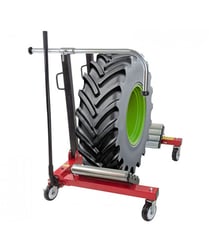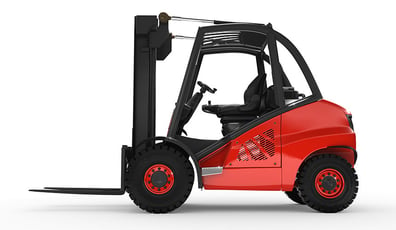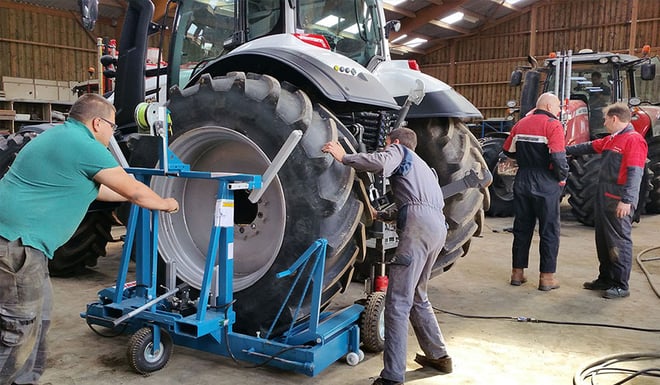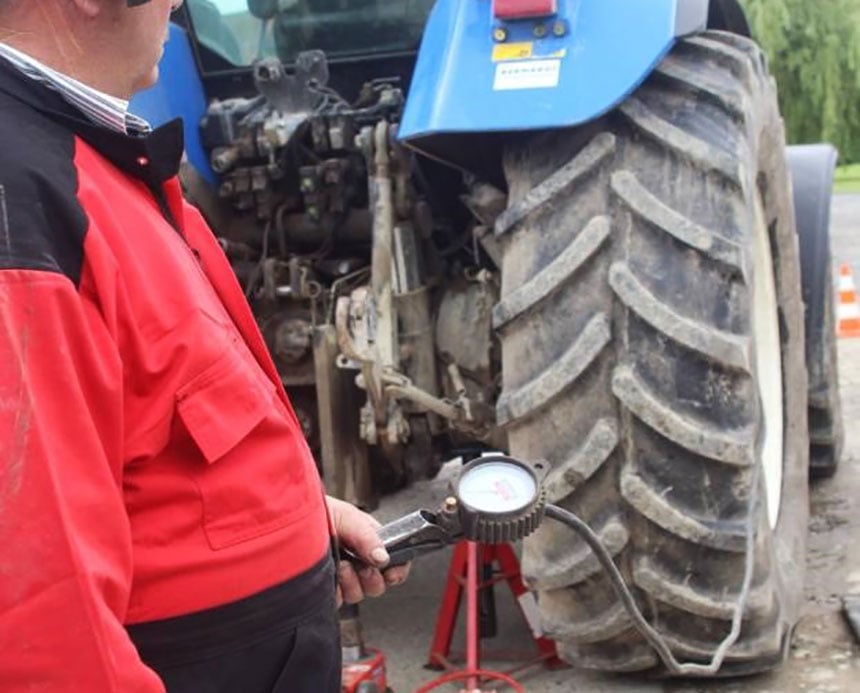During the year, you will inevitably have to handle your tractor tyres, whether to install seasonal tyre equipment, make repairs or store your equipment for the winter in the best possible conditions.
The weight and bulkiness of the tyres rapidly lead to handling difficulties, with a minimum amount of equipment required to avoid accidents or damage to a tyre, which can represent a major financial loss.
1. LIFTING THE TRACTOR: WHAT EQUIPMENT DO YOU NEED?
In general, with agricultural vehicles, for simple repairs or a tyre change, you don’t have to take off the wheel. In other words, the tyre is removed directly from the rim which remains fixed to the hub of the machine. The first step is therefore to raise the tractor using adapted lifting equipment.

Before any intervention, you must check if the tyre is water ballasted and ensure that it is completely deflated (or that both tyres are deflated in the case of twin tyres). To do this, just unscrew and remove the valve mechanism.
When the tyre is completely delated, you can go ahead and lift the tractor using the following equipment:
Chocks
If the vehicle is not properly secured, this can result in serious accidents.
As well as using the braking mechanisms, you must use chocks to be sure that the tractor is totally immobilised so that it doesn’t knock over the jack stands.
Ideally, place them diagonally under the wheels opposite the lifting point.
Jacks
These are indispensable to lift or lower your agricultural vehicle and must not be used for any other purpose. Their positioning varies based on several factors:
-
- the type of vehicle
- the make
- the type of transmission
- the suspension
The positioning of the jacks is systematically indicated on the vehicle, either using colour markings or position markers. If you have any doubt, check your tractor’s user manual to see where to position the jacks correctly.
Jack stands
These are essential to hold your agricultural vehicle in place. As their position is fixed, they are much safer than jacks which can give way, letting your tractor fall.
The jack stands allow you to secure the vehicle in the raised position and to prevent the risk of accidents linked to a faulty jack.
2. Dismounting and remounting a tyre
When all the safety measures have been taken, you can go ahead and dismount the tyre. Here are a few indispensable steps for the success of the operation depending on the available equipment:
Manual dismounting
If you intend to remove your agricultural tyre manually, you will need to lubricate the tyre bead after loosening it, to remove the tyre from the rim more easily.
If your rims are made up of several parts, we recommend starting by removing the locking ring and the side ring.
ATTENTION during dismounting, you should never be above or facing the wheel to avoid accidents. If you are working on a heavy goods vehicle “flat base rim” type wheel, the side ring may fly off, especially when the wheel is damaged or distorted due to a knock.
Mechanical dismounting
To facilitate the task and avoid wasting time, if you have the equipment, it is always preferable to use a tyre changer. However, the precautionary measures mentioned above should always be followed and ensure that the wheel’s tyre bead properly lubricated.
Precautionary tips
A tractor tyre is heavy, weighing on average 50 to 100 kg for the front drive wheels and 110 to 350 kg for the rear drive wheels, which means manual handling is not always an easy matter.
To avoid any accidents, tendinitis or pain linked to physical exertion, a few preventive measures are essential.

There are several kinds of equipment which make it possible to limit the manual carrying of heavy loads such as agricultural tyres.
For example, you can use:
- A front loader equipped with a pallet fork or manual lift truck, or pallet truck…
- Lifting equipment: hoist, monorail conveyor…
- Specialist trucks, accessible at a reasonable price.
When you remove your agricultural tyre, make sure that you carry out handling manoeuvres on a stable, flat surface.
Remounting: what you need to know
When you mount the tyre, make sure that you take all the precautions necessary to avoid accidents:
- Only use products that are recommended and approved by the manufacturer: you must not use adhesives, solvents, products containing hydrocarbons or a lubricant containing inflammable materials.
- Air inflation: keep as far away from the tyre as possible during inflation. If it bursts, the danger is real and irreversible.
Inflation advice: when you mount a tyre on a one-piece drop-centre rim, you must start the inflation ensuring that the tyre bead is correctly applied to the beadseat of the rim.
Never exceed the inflation pressure recommended by the manufacturer (around 2.5 bars depending on your tyres).
The principal dangers during inflation:
- Incorrection installation of the tyre bead on the beadseat of the rim which leads to the destruction of the tyre.
- Excess pressure (>2.5 bar) which leads to a risk of bursting or destruction of the bead as well as a high risk of explosion.
Safety recommendation:
- Position yourself in line with the tread as far away as the length of the pipe allows.
- Take into account the risk area and protect it.
- Use an air system equipped with a spring-loaded pressure regulator, set at the maximum tyre pressure.
Beware failure to follow instructions may lead to incorrect mounting and tyre bursting, which could lead to serious bodily injury or even death.
3. Transporting the tyres: necessary precautions
Incorrect handling may damage your tractor tyres permanently, in particular the beads. It is therefore advisable to use adapted lifting equipment giving priority to forklifts with rounded edges or flat fabric slings.

How to handle your tyres with lifting equipment
Lift the tyre by placing the forks only underthe outer circumference of the tyre (do not insert the forks into the beads).
Only forklift trucks with rounded forks can be used
to lift the tyre by the bead, but this is still not recommended.

How to handle your tyres with a sling
Lift the tyre only with a flat fabric sling, never use chains.ATTENTION : it is not advisable to use a hook, rope or chain to avoid damaging the metal rings situated at the level of the bead which ensure the connection to the rim.
These metal rings reinforce the casing while making the bead more rigid for better tyre steering and transmission of traction between tyre and rim.
To transport your tractor tyre without damaging it, this is the best adapted equipment:

Wheel balancer
|

Forklift truck
|
Wheel balancers
To avoid injuring yourself when handling your tractor tyre, using a wheel balancer allows you to transport a maximum load of up 1,200 kg with ease.
Thanks to its double action hydraulic system and its support arm, this piece of equipment ensures a safe and controlled lowering of the tyre during dismounting, while keeping the tyre straight and stable during handling.
Front loader or forklift truck
When mounting and dismounting very large wheels, it is advisable to use a front loader or forklift truck, or a specific tyre handler such as the “Mani-roues”.
This category of equipment allows to you secure the operation while gaining time.
Using these machines also makes it possible to avoid accidentally breaking the beads of your tyre by taking care to slide the forks under the tyre and never at the level of the centre of the tyre.
4. Tyre storage
Before storing your agricultural tyres, they must be carefully cleaned to remove stones and earth residue stuck between the lugs. If they are water ballasted, you must empty them completely before inspection:
- Evaluate the level of wear to the tread
- Identify any fissures and establish how serious they are (number, size)
- Check the sidewalls and, if possible, the inside of the tyre.
When your tyres are clean and dry, they must be wrapped up in a non-transparent tarpaulin to protect them from light, dust and humidity and avoid direct contact with the ground which could deform the structure. This precaution is also valid for tyres mounted on rims.
GOOD TO KNOW: your tyres age over time even if they are only used occasionally. There are many signs of tyre ageing: cracks on the sidewalls and tread, deformation of the casing…
Before using them after a long period of storage and increasing the tyre pressure, they must be thoroughly inspected to check their reliability.
The area where you store your tyres must be separate from repair and mounting areas. Try and find:
- A clean, dry area
- Away from direct sunlight or strong artificial light
- Far from heat, hydrocarbons and any inflammable materials.

To avoid deformation of the casing, we recommend that you store your tyres upright, preferably on pallets, ideally in adequate shelving if you have it. Otherwise, storing them in piles is possible on condition that you limit the number of tyres to avoid squashing the tyre at the bottom of the pile and only store them in this way for short periods.
For long-term storage, the ideal solution is to rotate your agricultural tyres regularly (a quarter of a turn). This reduces the negative impact of a long period of inactivity on the lower part of the tyre while considerably limiting the creation of small superficial fissures which are a sign of damage to the rubber.
5. Final recommendation
Interventions involving agricultural tyres can be tricky and sometimes require the use of adequate handling equipment to avoid accidents and damage to the tyres.
If you do not have the right equipment, don’t hesitate to ask a professional to carry out handling and repairs to your tyres. They are better equipped and experienced in this type of operation.
To take it a step further and increase the profitability of your farm, here is an ebook, downloadable for free, which explains the essential role of your tyres in the optimisation of your productivity.
Most people who read this article have also read some of the following articles:
- Info to help you know your agricultural tyres better and make savings
- Do you know the rules for storing your farm tyres correctly?
- The 3 best techniques for storing your agricultural tyres
- Do you know how to read all of the indications on your tractor tyres?
- All the secrets of tractor tyres, agricultural tyres or farm tyres
- Understanding the manufacturer’s technical information on agricultural tyres
- How to check the condition of your harvester tyres before the harvest
- Golden rules for managing tyre breakdowns during the harvest
This information is intended only to make you aware of the technical and functional aspects of agricultural tires and their use. It does not allow you to make a judgment or a definitive conclusion on a given problem. Only your agricultural tire expert is able to make a technical assessment and take a final decision, case by case.
Leave a
commentary
Your email address will not be published.
Required fields are indicated with *









